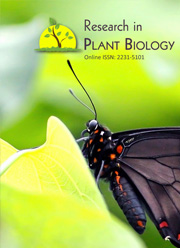Screening of fungi implicated in the dieback of olive trees (Olea europea) in Chebika’s area
Keywords:
Surveys, Olea europea, fungi, pathogenicityAbstract
Several surveys were conducted during spring 2008 in Chebika’s area in Tunisia. Samples were collected from infected plants showed different types of symptoms and they have been the subject of mycological analysis. The morphological identification of fungal colonies isolated from roots, crown and stems of two olive varieties Koroneiki and Chemlali Sfax, revealed the presence of a fungi complex including Fusarium oxysporum, Fusarium solani, Rhizoctonia solani, Verticillium dahliae, Cladosporium fulvum, Alternaria solani, Alternaria tenuis, Bispora punctata. and Cylindrocarpon .sp; Although,those fungi Fusarium oxysporum, Fusarium solani, Rhizoctonia solani and Verticillium dahliae are ubiquitous and the predominant one. Pathogenicity results revealed that the fungi isolated from olive trees exhibited typical symptoms on Koroneiki variety incontrolled conditions.Downloads
Download data is not yet available.
Published
15-10-2011
How to Cite
N, B.-M., M., S., I., B. S., S., S., & Romdhani, M. (2011). Screening of fungi implicated in the dieback of olive trees (Olea europea) in Chebika’s area. Research in Plant Biology, 1(4). Retrieved from https://www.updatepublishing.com/journal/index.php/ripb/article/view/2589
Issue
Section
Articles



 .
. 